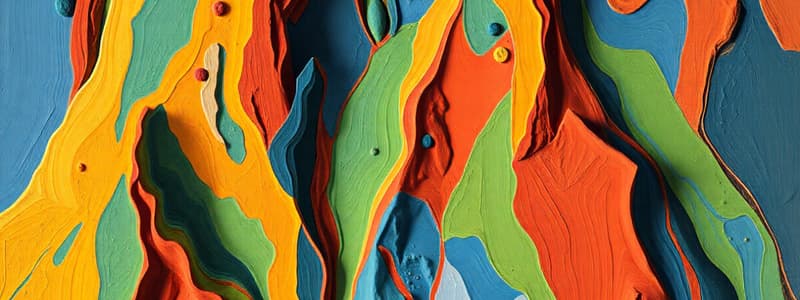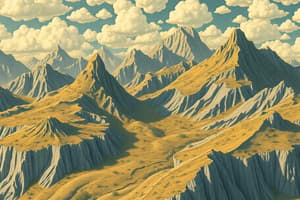Podcast
Questions and Answers
How does the geology of a region most directly influence geomorphic processes?
How does the geology of a region most directly influence geomorphic processes?
- By dictating the steepness of slopes.
- By influencing the susceptibility of the land to erosion. (correct)
- By controlling the rate of temperature change.
- By determining the average annual precipitation.
A region that was once covered by a large glacier has a landscape characterized by ridges of unsorted sediments. What are these features called?
A region that was once covered by a large glacier has a landscape characterized by ridges of unsorted sediments. What are these features called?
- Moraines (correct)
- Dunes
- Alluvial fans
- Delats
Which of the following human activities will most likely lead to accelerated erosion rates in a mountainous region?
Which of the following human activities will most likely lead to accelerated erosion rates in a mountainous region?
- Practicing sustainable agriculture.
- Constructing a large dam. (correct)
- Promoting reforestation efforts on barren hillsides.
- Implementing strict regulations on construction activities.
How can geomorphology contribute to predicting natural hazards in a mountainous area?
How can geomorphology contribute to predicting natural hazards in a mountainous area?
A research team is studying sediment deposits to infer past climate conditions in a specific region. Which aspect of geomorphology are they primarily utilizing?
A research team is studying sediment deposits to infer past climate conditions in a specific region. Which aspect of geomorphology are they primarily utilizing?
A landscape characterized by broad, flat areas at high elevation, often bounded by steep cliffs, is best described as a:
A landscape characterized by broad, flat areas at high elevation, often bounded by steep cliffs, is best described as a:
In which of the following environments would wind erosion likely be the MOST dominant erosional force?
In which of the following environments would wind erosion likely be the MOST dominant erosional force?
Which process is MOST responsible for the breakdown of rocks into smaller pieces without changing their chemical composition?
Which process is MOST responsible for the breakdown of rocks into smaller pieces without changing their chemical composition?
Which of the following scenarios would result in the HIGHEST rate of river erosion?
Which of the following scenarios would result in the HIGHEST rate of river erosion?
Which of the following depositional environments is MOST likely to be associated with the formation of an alluvial fan?
Which of the following depositional environments is MOST likely to be associated with the formation of an alluvial fan?
What is the primary difference between erosion and weathering?
What is the primary difference between erosion and weathering?
A large boulder is being transported by a river. Which transportation process is MOST likely moving the boulder?
A large boulder is being transported by a river. Which transportation process is MOST likely moving the boulder?
How do glaciers contribute to landscape evolution?
How do glaciers contribute to landscape evolution?
Flashcards
Moraines
Moraines
Sediments deposited by glacial movement and melting.
Climate Impact
Climate Impact
Factors like temperature and precipitation drive weathering and erosion rates.
Topography's Role
Topography's Role
Steep slopes increase the rate of erosion compared to flat land.
Geomorphic Processes Over Time
Geomorphic Processes Over Time
Signup and view all the flashcards
Human Impact on Geomorphology
Human Impact on Geomorphology
Signup and view all the flashcards
Geomorphology
Geomorphology
Signup and view all the flashcards
Weathering
Weathering
Signup and view all the flashcards
Physical Weathering
Physical Weathering
Signup and view all the flashcards
Chemical Weathering
Chemical Weathering
Signup and view all the flashcards
Erosion
Erosion
Signup and view all the flashcards
Transportation in Geomorphology
Transportation in Geomorphology
Signup and view all the flashcards
Deposition
Deposition
Signup and view all the flashcards
Landform Types
Landform Types
Signup and view all the flashcards
Study Notes
Introduction to Geomorphology
- Geomorphology is the scientific study of landforms and the processes that shape them.
- It examines the evolution of landscapes over time, from the formation of mountains to the erosion of valleys.
- Geomorphic processes include weathering, erosion, transportation, and deposition.
Types of Landforms
- Landforms can be classified into various categories based on their origin and characteristics.
- Some major categories include:
- Mountains: Formed by tectonic uplift, volcanic activity, or erosion.
- Plains: Expansive flat areas, often formed by depositional processes.
- Plateaus: Elevated flat areas, typically bordered by steep slopes.
- Valleys: Depressions formed by erosion of rivers or glaciers.
- Coastal landforms: Features shaped by the interaction of sea and land.
Weathering Processes
- Weathering is the breakdown of rocks and minerals at or near the Earth's surface.
- Two main types of weathering processes:
- Physical weathering: Breakdown of rock into smaller fragments through physical forces, such as temperature fluctuations, frost wedging (ice expansion), and abrasion.
- Chemical weathering: Breakdown of rocks and minerals through chemical reactions, including oxidation, hydrolysis, carbonation, and others.
Erosion Processes
- Erosion is the process of transporting weathered material by natural forces.
- Agents of erosion include:
- Water (rivers, streams, oceans): Main agent in many environments, with varying energy; faster flow carries larger particles.
- Wind: Important in arid and semi-arid regions, transporting sand and dust.
- Ice (glaciers): Erode by abrasion and plucking, shaping landscapes.
- Gravity: Plays a role in mass wasting processes like landslides and creep.
Transportation Processes
- Transportation involves the movement of eroded material by various agents (e.g., rivers, wind, ice).
- The type of material transported depends on the energy and mechanisms of the transporting agent.
- Larger particles require more energy.
- Materials can be transported in solution, suspension, or as bedload.
Deposition Processes
- Deposition is the process by which transported materials are laid down.
- The rate and nature of deposition are influenced by the energy of the transporting agent.
- Depositional features include:
- Alluvial fans: Formed at the foot of mountains where streams emerge.
- Deltas: Form where rivers flow into a larger body of water.
- Glacially deposited sediments (moraines): Created by the movement and melting of glaciers.
Factors Influencing Geomorphic Processes
- Climate (temperature, precipitation, humidity): Drives both weathering and erosion rates.
- Topography: Steep slopes increase erosion rates.
- Geology (rock type, structure): Controls susceptibility to erosion.
- Time: Geomorphic processes operate over varying timescales, from short-term events (floods) to long-term cycles (mountain formation).
- Human activities (e.g., deforestation, dam construction) can significantly alter natural geomorphic processes.
Applications of Geomorphology
- Understanding landscape evolution
- Predicting natural hazards (landslides, floods).
- Developing sustainable land management practices.
- Assessing the impacts of climate change on landscapes.
- Reconstructing past climates and environments.
Studying That Suits You
Use AI to generate personalized quizzes and flashcards to suit your learning preferences.




